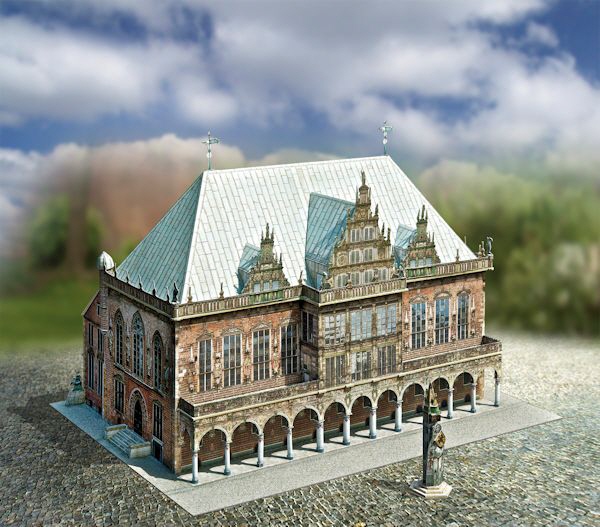Bremen Old Town Hall

scale 1:160
length 30 cm
width 20 cm
height 20 cm
degree of difficulty 1
number of sheets 5
Bremen Old Town Hall
The Old Town Hall in Bremen is one of the most important buildings in the Gothic and Weser Renaissanace styles Europe-wide. Together with the statue of Roland on the Market Square it has been a listed building since 1973 and in 2004 it was made a World Heritage Site. It is situated very close to the cathedral and the “Bremen Bürgerschaft”, the parliament of the Federal State of Bremen.
The Old Town Hall was built from 1405 to 1410 as a Gothic hall building, a so-called “Saalgeschossbau”. The battlements and walkway no longer exist. Shortly after it was completed it became necessary to make the first alterations. In about 1600 it was decided to replace the Gothic front with a façade in the Weser Renaissance style. It is decorated with numerous figures from politics, the ancient world, the Bible and the world of legends and myths.
In the 19th century the city administration was moved to the neighbouring town house. But soon they didn’t have enough room there. For this reason, from 1909 to 1913 the New Town Hall was built behind the Old Town Hall. The New Town Hall is a clinker construction with a copper roof in the style of the Neo-Renaissance. The Town Hall survived the bombs of the Second World War without much damage and has been restored several times. The last restoration took place in 2003.
The Statue of Roland
The Bremen statue of Roland represents a nephew of Charlemagne and is the largest free-standing statue of the German Middle Ages. It was erected on the Market Square in 1404. The pedestal, supporting column, figure and baldachin have a total height of 10.21 m. The figure itself is 5.47 m tall and was carved in limestone from Elm. The pedestal, column and baldachin are made of sandstone. Originally the statue was colourfully painted, in the 18th century it was then painted grey and later sparingly coloured. In 1811 the Roland was supposed to make room for a market hall. But then the plan was rejected. The statue remained practically undamaged in the Second World War thanks to a wooden casing filled with sand. In 1983 the head was replaced by a reproduction. The original can be seen in the Focke Museum.
According to legend, the City of Bremen will remain free and independent for as long as Roland stands on the Market Square. For this reason, it is alleged that a second statue is kept in the Town Hall’s underground vaults. The legend probably goes back to a wooden reproduction from the First World War. Everyone who donated money towards a Home for Soldiers was allowed to knock a nail into this figure. That was why this figure was also called “The Iron Roland”.
Several ships have been named after the Bremen landmark. In 1932, German emigrants named the Brazilian town Rolândia after the statue. Of course, there is also a reproduction of the statue in this town. Further reproductions can be found in the New York Borough of Brooklyn, in a Japanese amusement park and in Quito, the capital city of Ecuador.
